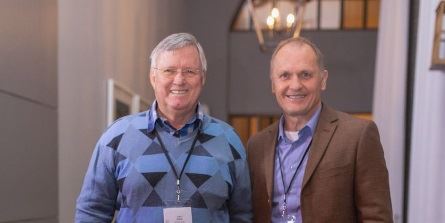Rhino Coin, a new cryptocurrency aimed at combatting rhino poaching, was launched in Johannesburg on June 7. The founders are hoping that the currency will create a steady source of sustainable income for rhino conservation.
Based on a private blockchain built on Ethereum, Rhino Coin will take the form of a digital currency that will unlock the value of ethically obtained, stockpiled rhino horn, creating a new stream of revenue for conservation as well as creating a trading opportunity for coin holders.

John Hume, the largest rhino breeder in the world, with Ian Wilcocks of Rhino Coin.
Alexander Wilcocks, co-founding member of Rhino Coin, said: “We have moved the digital currency – often confusing to understand – to a real world, physical asset.”
Wilcocks believes this gives both local South Africans and those interested internationally a platform to get involved. “We urge people to get involved locally and globally. People overseas interested in helping us in our fight can sign up and start trading immediately on our online platform.”

Alexander Wilcocks and Jaques Durandt, co-founders of Rhino Coin.
Of the coin value, 74% will be given to the newly-formed Rhino Coin Foundation (RCF) for allocation to best-practice conservation programmes, and the remaining 26% will go towards the continued development and maintenance of the trading platform.
RCF is a fully-independent NGO, operating on the mandate of managing and directing the funds provided by the sale of Rhino Coin. RCF’s board is made up of veterinarian and wildlife surgeon, Dr. Johan Marais, conservation journalist Emmanuel Koro, conservationist and documentary filmmaker Phillip Hattingh, and TV presenter and author, Braam Malherbe.
Speaking at the launch, Koro said that the board will look at the allocation of funds on a project by project basis. “We are aiming to create direct links between the money and the animals, as well as communities. Too often, money is donated to conservation efforts, and the people on the ground living in the areas and doing the hard work don’t see a cent of it. Where does that money go? With our foundation, there will be a direct link between the money we receive and the projects we allocate it to,” he said.
Koro emphasised the role of local communities in conservation. “There needs to be community involvement in the conservation of wildlife and currently that is not the case. The spirit of conservation does not exist in those communities living side by side with wildlife, next to nature reserves and game parks. If there is no understanding of the role of wildlife and no benefit for these people, then why should we expect them to want to be involved? Our objective at RCF is to get these people involved, to help give them a sense of ownership over the land and the wildlife so that they will fight with us against the poachers.”
Jaques Durandt, co-founding member of Rhino Coin added that Rhino Coin will also address the problem by providing an alternative mode of income to poaching: “By providing communities a better means to receive a sustained income, we hope to lower the benefit and temptation of participating in illegal poaching in the immediate areas.”
Wilcocks emphasised the spin-off value of conservation for tourism. “People come to southern Africa to see our wildlife. If there is no more wildlife, our tourism industry will suffer hugely. So this is a way people in the tourism industry can get involved in feeding funds directly to conservation efforts,” he said.
Marais told the audience that the reasons for poaching are not the same as they were five years ago. He explained that rhino horn – as well as other commodities like ivory, pangolin scales, lion bones and fur – is no longer commonly used for medicinal purposes, as it was a few years ago. Today, these items are symbols of wealth and status, displayed on office desks, worn as jewelry and given as high-end gifts. He said: “It’s now about wealth, not health.”
Marais used research done by undercover operatives in Asia to demonstrate how easy it is to purchase these items online. He added: “The people making money from this trade are banking on these animals going extinct, which will cause the price of these items to grow hugely. If there are no more rhino, the rhino horn that is left will skyrocket in value.”
As a vet and member of the RCF board, Marais hopes some of the money raised will be able to assist in the treatment of rhinos injured by poachers. He has pioneered treatment options for animals with severe facial injuries, and though the treatment is costly, he has seen success. “If we can save an animal, that animal can go on to breed, which helps grow the population exponentially, generation by generation," he explained.
For more information and to start trading Rhino Coin, click here.
This article has been update since publishing.























